Team Jul 27, 2022 No Comments
The lives of individuals, businesses, and industries have been devastated by Covid-19. The world came to a halt in 2020 and has started to resurrect itself in a completely new dimension. The Covid-19 pandemic shows the vital necessity for fast and reliable data sources that are both individualized and population-wide to generate data-driven insights into disease surveillance and control, because of its tremendous consequences on global health and economics. This is where data science comes in. The impact of data science post covid is huge.
Every company benefits from data science post covid With the increasing complexities and shifting needs of customers, data is becoming increasingly important. Data Science combines programming, mathematics, and statistics ability to develop data-driven insights using statistical figures, patterns, and trends. Because they are unable to function according to their initial business goals, the present Covid-19 situation has added to the complications for businesses.
Covid-19 has broken the historical analytics paradigm so significantly, according to McKinsey, that pre-Covid data must be viewed in a separate historical context. The quick breakout of the pandemic compelled organizations to make a sudden jump to accommodate the changing requirements of the moment. However, other businesses and sectors adapted successfully to the circumstance by developing new data science procedures that could be implemented much more quickly. As entire operations had to be moved to a completely remote and wireless platform, the following trends were expected to be observed in Data Science trends.
• More technology-driven research.
• More connected infrastructure.
• Brands attempting to keep up with the fast-paced digital maturity required to stay relevant and competitive.
Data science volume utilizes large volumes of data to make an informed decision regarding business. It is basically a study to formulate new products. Typically, data analysts analyze data and find new insights. They support companies in making progress with gathered data. Modern data analysts can be called part mathematicians, part computer scientists, and also part trend spotters. They operate in advanced ML (Machine Learning) frameworks and are aware of the technicalities to anticipate future customers or market behavior dependent on previous trends.
The goal of businesses from data analysts is to make decisions that are data-driven for a powerful business impact. Demand for data scientists is relatively high with great opportunities to evolve. However, with the latest coronavirus pandemic, there was a bit of flattening out of the demand. Currently, after two years of the pandemic, there are no indications of a decrease in the demand for data scientists and a slowing down of data science.
With evolving data, the requirement for data analysis and making sense of the assembled data is also rising. Hence, there is no such thing as data science post covid. There is a sky-high pay and evolving demand for data scientists in several companies. It has resulted in a serious upward career arc.
The role of Data Science has become all the more important after the Covid-19 crisis. For example, industries that have incurred losses will adopt more aggressive business approaches to improve sales and better understand the needs of the customers. Economic and everyday life disturbances can force any company to make considerable changes in order to stay competitive. And that is what has happened with the pandemic. Companies started using Data Science to their advantage in the following ways.
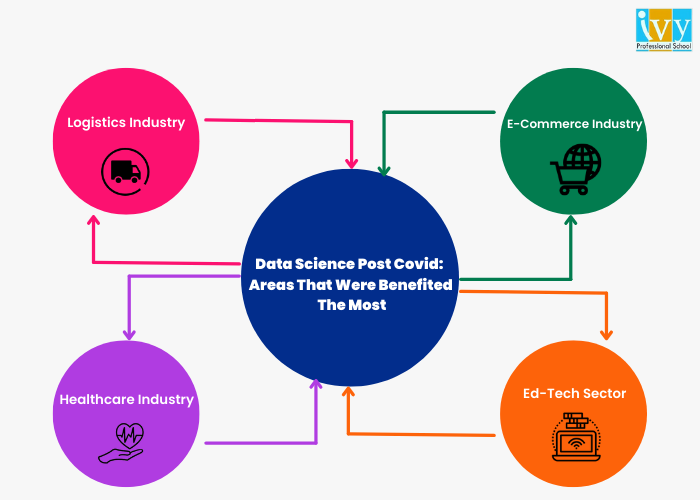
The key areas where data science has gained paramount importance post-Covid 19 are as follows.
The logistics industry went through a massive change post-Covid and Data Science has a significant role to play in it.
The AI model data helps companies understand different kinds of scenarios and limitations such as geographical restrictions that may be in effect due to rising Covid-19 cases.
Predictive analytics is a significant application of Data Science in healthcare. The predictive model examines and learns from historical data, identifying trends and making predictions based on them.
Individuals use the digital space in healthcare to explore better services and delivery because the risk of visiting a hospital during Covid-19 is very high. In healthcare, data science assists hospitals in identifying many symptom connections among a group of users on health portals. By creating records, hospitals can improve special care. They can also improve supply chain efficiency to improve patient outreach.
People used to go to malls to shop and eat at restaurants a few years ago. Customers began to shop from online platforms at their leisure after the Covid 19 outbreak, avoiding the risk of contracting the virus.
People are now able to purchase products of their choice from the comfort of their own homes, and artificial intelligence is presenting them with an experience akin to that of a physical visit. Customers of online shopping platforms receive a customized experience based on their data profiles.
The industry shifted most of the world into emergency remote learning settings after Covid-19 hit the world and led to the temporary closure of schools and educational institutes. Educational Institutions around the world shifted to video conferencing capabilities, online learning management software, and other digital alternatives.
The use of software and data science in the education industry to predict the use and effectiveness of delivery systems is still improving. Data science aids in determining the total impact of existing tools and software, as well as maximizing the use of technology to enhance the learning experience.
The effect of AI (Artificial Intelligence) on the economy and on our lives has been quite astonishing. There are countless instances and applications of AI. Expectations from AI are human-like and the artificial intelligence technologies are categorized into sense, comprehend, and act. The machine must perceive and sense the data via audio-visual processing. It must identify the pattern and evaluate the data as a pattern or context. AI must allow the machine to obtain potential insights that can support actions.
One of the prominent challenges in adopting AI is privacy. AI operates on a huge volume of confidential data. The data is seldom sensitive and personal. Unclear security, privacy, and ethical regulations formulate a plethora of challenges. In some nations, the General Data Protection Regulations (GDPR) act adds further obstacles to the adoption of AI. Along with that, AI requires highly trained and skilled professionals. Scarcity of awareness of the adoption of AI in businesses, technology, infrastructure, and research poses further issues. However, entities and businesses are aggressively adopting AI and aiming at diversifying it.
As a result, the post-COVID-19 age presents a chance for the next generation of data scientists. Data science post covid witnessed immense popularity and significance. However, data scientists must drastically improve their skills to advance to the next level. There are various opportunities to upskill and make a career in the field of Data Science. When it comes to Data Science, one institute that deserves a special mention is Ivy Pro School.
Since 2008, Ivy Professional School has continuously ranked among the top data science and analytics training institutions. Ivy has well-accomplished faculty with more than ten years of industry experience. It aims to provide specific learning experiences that organizations are looking for in their prospective data science candidates.
Team Jul 22, 2022 No Comments
How do you think you get product recommendations on an E-commerce site or how do you think taxi booking services monitor traffic conditions and adjust prices accordingly? The answer is “Data Science”. With technological advancements and growing changes in the world of business, Data has become of paramount importance to industries, corporate houses, and government sectors. This is where the science behind data comes in. Here is an easy data science guide for you.
In simple words, Data Science is the field of study that deals with huge volumes of data using new-age techniques and tools. It finds patterns and derives meaningful insights from the vast amount of unstructured data and helps businesses make informed decisions. The data that is analyzed comes from various sources and is presented in different kinds of formats. Data Science comprises various tools, machine learning principles, and algorithms that assist in discovering hidden patterns from the available raw data.
Earlier, the data that we had was mostly structured and very small in size and therefore it was easier and simpler to analyze it. In recent times, the data generated from various sources is mostly unstructured or semi-structured. This cannot be analyzed or processed with simple BI tools. To analyze and draw insights from these data obtained from text files, multimedia forms, financial logs, and instruments, more complex and advanced analytical tools are required. This is the reason why Data Science is gaining so much popularity these days.
The usability of data science is huge. It is used in almost all sectors and is given utmost importance. Especially, in post covid era, the use of data science has increased. This infographic will give you a gifted idea of the areas where data science is sued.
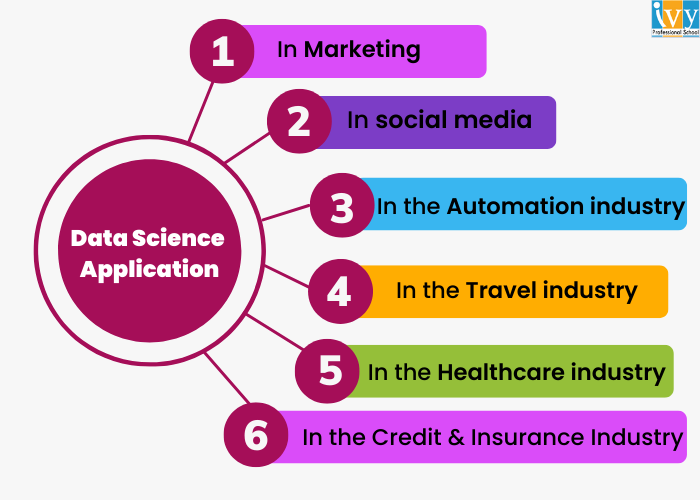
Let us now examine how Data Science is being used beneficially across multiple fields and sectors.
• In Marketing, Data Science is used for getting valuable customer insights, real-time interactions, customer segmentation, targeting, cross-selling, and predicting the lifetime value of a customer.
• In Sales, Data Science is used for future sales prediction, discount offers, etc.
• In social media, Data Science is used for measuring marketing performance KPIs, monitoring the effectiveness of campaigns, creating personalized ads, sentiment analysis, and much more.
• In the Automation industry, Data Science is used for self-driven cars.
• In the Travel industry, Data Science is applied to predicting flight delays and dynamic pricing.
• In the Healthcare industry, Data Science is applied for medication effectiveness and the prediction of diseases.
• In the Credit & Insurance Industry, Data Science detects fraud and risks and is also used for claims prediction.
In this data science guide, it is crucial that we look into the job profile of a data scientist. Data Scientists are those who crack complicated data issues along with the strong expertise in several scientific disciplines. They operate with various elements associated with mathematics, computer science, statistics, and many more. They make a lot of utilization of the latest technologies in finding solutions and attaining conclusions that are important for the development and growth of an organization. Data scientists offer the data in a much more effective and useful format in comparison to the raw data that is available to them in structured along with the unstructured forms. All data scientists should hold a data science degree.
The Data Science profession is challenging but fortunately, many tools make the job of Data Scientists easier. Some of the tools include MATLAB, Excel, SAS, Jupyter, Tableau, Cognos, R Studio, RAW, Azure ML studio, and much more. Owing to the increasing demand for the subject in the industry, there is a rising need for more and more professionals to have in-depth knowledge about Data Science. Data Science jobs are not only high paying but are also in demand. There are many definitions available for Data Scientists. A very common definition of Data Scientists is that they are people who know the art of Data Science. They crack complex problems with their knowledge and work with several elements like mathematics, computer science, statistics, etc. Data Scientists offer data in a useful way. Data Scientist experts are needed in every sector and tech company. They are highly educated and are in demand these days. The various Data Science job options are Data Scientist, Machine Learning Engineer, Machine Learning Scientist, Application Architect, Enterprise Architect, Data Engineer, Data Engineer, and much more.
The process of analyzing and acting upon data isn’t linear and the Data Science lifecycle flows in the following ways.
• Defining a project and its potential outputs.
• Exploring, pre-processing, and conditioning the data before modeling. Data Scientists need the right tools and access to the right data.
• In this phase, model planning is done where one needs to determine the techniques and methods to draw a relationship between two variables. Various common tools are used for model planning.
• In this phase, Data Scientists develop datasets for training and testing purposes. Various learning techniques are analyzed to build the model.
• In this phase, final reports, briefings, and technical documents are delivered. A pilot project is executed at this stage.
• In this phase, the results are communicated to the stakeholders.
There are many Data Science guide courses available that will help you build a successful career in the field of Data Science. However, it is very important to pursue the course from the right place. Ivy Professional School is the pioneer in Data Science and has committed to providing in-depth subject knowledge to the students to make them professionally competent. Ivy Pro School’s collaboration with NASSCOM will unlock great opportunities for Data Science candidates and help them build the career of their dreams. The Data Science course at Ivy Pro School includes high-demand tools like Python, R, Tableau, SQL, Adv Excel, VBA, etc. So if you are interested in building your skills in the field of Data Science, the best way to learn data science is with us. Hope this guide about data science for beginners helped you.
1. Can I self-learn data science?
One can learn data science on their own with online data science courses or also even from YouTube videos. There is no paucity of learning materials on the internet if one is working towards a career in this field. Having said that, self-learning lacks structure, and one might not know what crucial elements one is missing.
2. What is data science A Beginner’s Guide to data science?
In simple words, Data Science is the field of study that deals with huge volumes of data using new-age techniques and tools. It finds patterns and derives meaningful insights from the vast amount of unstructured data and helps businesses make informed decisions.
3. What are the basics needed for data science?
In Marketing, Data Science is used for getting valuable customer insights, real-time interactions, customer segmentation, targeting, cross-selling, and predicting the lifetime value of a customer.
Team Jul 20, 2022 No Comments
Analytics is the communication and discovery of effective and meaningful patterns in data. Mainly, valuable in niches filled with recorded information, analytic dependence on simultaneous dependence of statistics, and so on. Analytics seldom favors the visualization of data for communicating insights. There are some distinct types of data analytics that you should know before you aim to start learning this.
Businesses may commonly apply analytics to business data, to illustrate, anticipate, and enhance business performance. Primarily, in niches within involve enterprise decision management, predictive analytics, and so on. Since analytics can need extensive computation, the software, and algorithms that are used to harness the most present procedures in computer science.
In a gist, data analytics is the scientific procedure of changing data into insights for implementing better decisions. The aim of data analytics is to receive actionable insights that will result in smarter decisions and better business results. It is important to design and construct a data warehouse or BI (Business Intelligence) architecture that offers a flexible, multi-faceted analytical eco-space, boosted to effective analysis and ingestion of diverse and large sets of data.
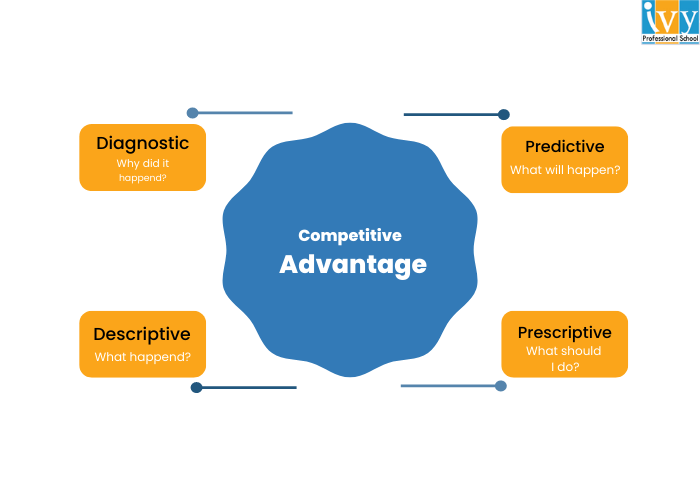
With that, let us dive into knowing the 4 primary types of data analytics that are effective in the present working scenario.
Predictive analytics turn the data into actionable, valuable data. This type of analytics employs data to evaluate the probable impact of an event or even a likelihood of a situation that is occurring.

This form of analytics holds a variety of statistical methods from the machine, modeling, data mining, and game theory that analyze present and historical facts to make predictions regarding the upcoming events. Techniques used in this type of data analytics include:
• Linear Regression
• Time series analysis and forecasting
• Data Mining
Having said that, there are three primary cornerstones of predictive analytics. And here they are:
• Predictive modeling
• Optimization and decision analysts
• Transaction profiling.
Descriptive analytics looks at data to evaluate previous events for insight as to how to approach upcoming events. It looks at the previous performances and evaluates the performances by mining historical data to find out the cause of success or failure in the past. Nearly all management reporting like sales, operations, marketing, and finance utilizes this type of analysis.
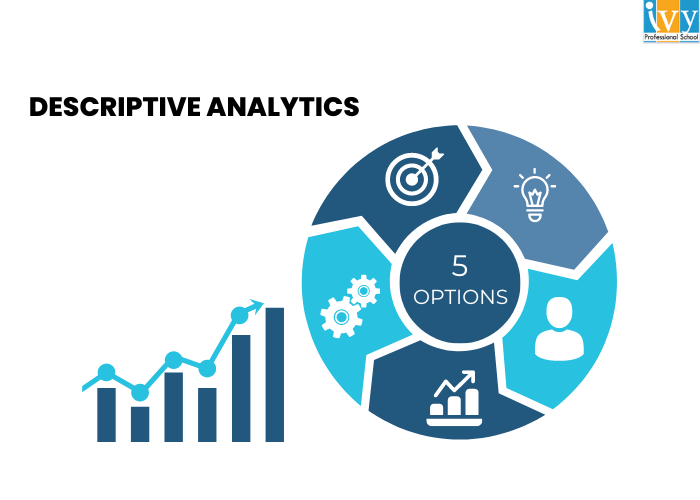
The descriptive structure quantifies relationships in data in a way that is seldom used to distinguish users or prospects into groups. Unlike a predictive structure that aims at predicting the behavior of a single customer, this type of data analytics identifies several varied relationships between product and user.
Common instances of descriptive analytics are company reports that offer historic reviews such as:
• Data Queries
• Reports
• Descriptive Statistics
• Data Dashboard
Prescriptive analytics is basically where big data and AI mix to help anticipate outcomes and identify what actions to take. This segment of analytics can be further broken down into random testing and optimization.
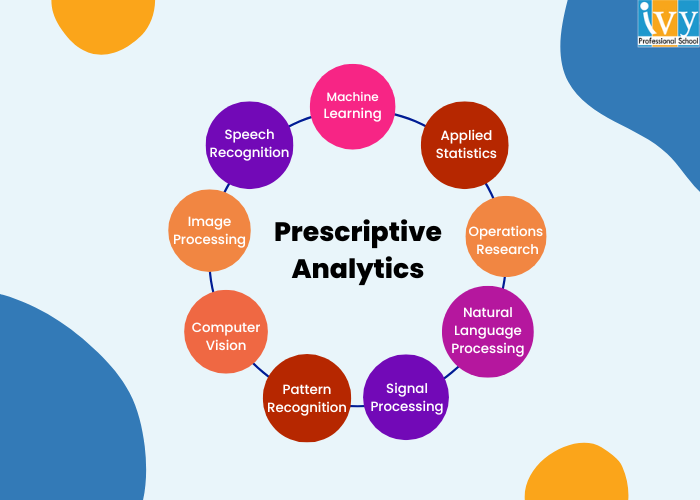
Employing advancements in ML, prescriptive analytics can help answer questions like “what if they try this?”. You can go through the ideal variables and even recommend new variables that provide a greater chance of developing a positive result.
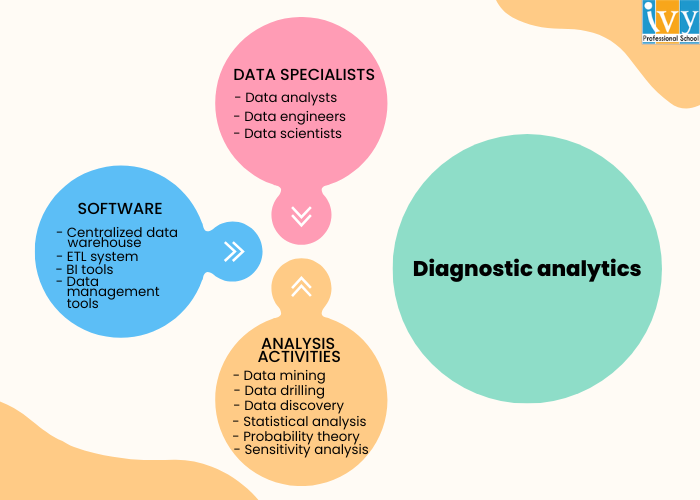
Diagnostic data analytics helps in answering questions on why something happened. Like the other segments, it too is broken down into two more prominent categories: query and drill down and discover and alerts. Query and drill downs are used to receive more details from the reports. For instance, a sales report that closed prominently fewer deals one month. A drill down should portray fewer workdays, because of a two week vacation.
Discover and alert notify of a prominent issue before it takes place, for instance, an alert regarding a small number of staff hours which could result in a reduction in closed deals. You could also avail this form of data analytics to “discover” data like the most qualified candidate for a new position at your entity.
Considering the increases in the types of data analytics jobs, if you wish to construct a more insight-driven organization, there are ample data analytics products on the market presently. Finally, the perfect solution provides modern data analytics tools that are predictive, self-learning, intuitive, and adaptive. To support all the ways that your organization will employ data, here are a few points to keep in mind.
• You wish for a single platform that combines data and analytics management capabilities. Such a solution avoids the compatibility and access problems of a legacy ecosystem that has several solutions for discovery, reporting, recommendations, and analysis. Everything is included and integrated so it will be more convenient to provision and bring business value quicker.
• A platform that remains in the cloud, but can access data on-premises and or in a hybrid scenario is key. Quick, convenient access to the data along with analytics allows everyone across the company to receive insight and also make informed decisions.
Search for a solution that supports the whole analytic procedure, from gathering data to offering prescriptive actions and insights along with security, reliability, flexibility, and speed.
Select a solution that analyses and accesses available data that is of any size and in any location from departments, third parties, applications, unstructured and structured, on-site, and finally in the cloud. Such solutions streamline the processing of data to unlock the real value of your data, uncovering the hidden patterns and relevant insights to help the customers make informed, and data driven decisions.
For trustworthy analytics, results, and insights, data should be consolidated into a single source. Doing so enables for accuracy and consistency along with a unified view of data, insights, and metrics.
Search for a solution along with augmented analytics like embedded AI and also machine learning to accelerate, simplify, and automate actions, offering you the power to dig faster and deeper into your niche. It automatically consolidates and collects data from several sources and suggests the latest datasets for analysis.
Analytics has the ability to offer you a detailed image of your business landscape. To help make the most of that power, you will require a smart solution that can automatically change data into visual presentations. This enables you to witness and understand patterns, trends, and relationships that might be skipped with a spreadsheet of raw numbers. It also allows you to create data mash-ups to receive unique, new insights. You can also do that without any specialized training because of smart technology.
You will need a solution that can offer your people access to the data they require when they are on the road. But not all mobile analytic solutions are formed equal. Think of a mobile analytic solution that not only provides voice-enabled access and real-time alerts but offers advanced capabilities to allow your people to be even more productive.
As we have seen, each of these types of data analytics is connected and depends on each other to a certain degree. They can serve varied purposes and offer varying insights. Shifting from descriptive analysis towards predictive analysis and prescriptive analysis needs much more technical ability, but it also unlocks more insight for your organization.
After knowing about the various types of data analytics, if you are willing to take your career forward in data analytics, then you will need to be certified. And for the best certification and courses on data analytics, you can join Ivy Professional School. They offer numerous courses on data analytics by industry experts. You can easily have a look at all the courses offered by Ivy Professional School.
1) What are the 5 data analytics?
At varying stages of business analytics, a big amount of data is processed, and relying on the need of the type of analysis, there are mainly 5 types of analytics – Diagnostic, Predictive, Prescriptive, Descriptive, and Cognitive analytics.
2) What are the 4 types of analytics?
The 4 types of analytics are Predictive Analytics (Forecasting), Descriptive Analytics, Prescriptive Analytics, and Diagnostic Analytics.
3) What are data analysis methods?
Data analysis is a method that typically includes several activities like gathering, cleaning, and also organizing the data. These methods, which usually involve data analysis software, are important to prepare the data for business aims.